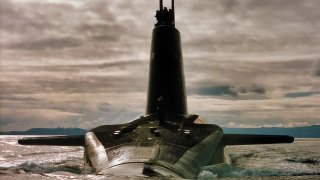Royal Navy's Vanguard-Class Missile Submarine Has Just 1 Goal
The Royal Navy's Vanguard-class ballistic missile submarines, introduced in the 1990s, have served as the backbone of the UK's sea-based nuclear deterrence. These vessels, which are the largest of their kind built in the UK, were equipped with American-made Trident missiles, capable of striking targets up to 4,000 miles away.
The Main Point: The Royal Navy's Vanguard-class ballistic missile submarines, introduced in the 1990s, have served as the backbone of the UK's sea-based nuclear deterrence. These vessels, which are the largest of their kind built in the UK, were equipped with American-made Trident missiles, capable of striking targets up to 4,000 miles away.
Powerful Submarines: With advanced sonar systems and heavyweight torpedoes, the Vanguard-class has provided robust anti-submarine and anti-surface warfare capabilities.
Retirement Is Coming Soon: Although these submarines are nearing retirement, their Trident missiles will be carried over to the next generation of Dreadnought-class submarines, set to serve until at least the 2060s.
Vanguard-Class Submarines: The Backbone of Britain's Nuclear Deterrence
The Royal Navy’s fleet of Vanguard-class ballistic missile submarines is aging and soon to be replaced, but these SSBNs proved their worth over decades of service. The Vanguard ships are the largest of their kind manufactured in the United Kingdom, displacing nearly 16,000 tons when submerged – twice the displacement of the preceding Resolution-class Polaris submarines.
Four Vanguard-class vessels were introduced to the Royal Navy in 1994 as part of the Trident nuclear program: Vanguard (S28), Victorious (S29), Vigilant (S30), and Vengeance (S31).
The History of the Vanguard-Class
Like most Western military systems created during the Cold War, Britain designed the Vanguard class to deter the Soviet Union. Unlike the U.S., whose deterrence strategy involved a full nuclear triad, the UK focused primarily on sea-based nuclear deterrence. Resolution-class vessels were equipped with Polaris missiles.
When determining the armament of the new Vanguard ships, it was decided that the American-made Trident would deliver the best long-term capability insurance against the USSR’s growing arsenal. Then-Prime Minister Margaret Thatcher asked to purchase Trident missiles, and the two countries reached an agreement in the early 1980s.
Specs & Capabilities
The British Ministry of Defense selected Vickers Shipbuilding and Engineering (currently BAE Systems Submarines | Maritime) to build the Vanguard. The lead ship of the class – the HMS Vanguard – was commissioned in 1993, followed by the HMS Victorious in 1995, the HMS Vigilant in 1996, and the HMS Vengeance in 1999. Each of these ships is powered by nuclear propulsion, allowing them to sail for longer periods of time without needing to refuel. The class’s endurance is estimated at 60 days.
The Vanguard carries the UK’s essential nuclear deterrent, the Trident missile. These weapons can be fired at targets up to 4,000 miles away and are ejected from the ship’s ballistic missile tubes via “high-pressure gas before igniting when they reach the surface of the water,” as explained by the Royal Navy.
The Vanguard SSBNs are also fitted with four 21-inch (533mm) torpedo tubes and can carry up to 16 Spearfish heavyweight torpedoes. Capable of traveling faster than 90 miles per hour, these torpedoes can strike targets with a 660-pound explosive charge, giving the Vanguard ships both anti-submarine- and anti-surface-warfare capabilities.
The Vanguard’s sensors are also sophisticated, including the Thales Underwater Systems Type 2054 composite sonar system. Reportedly, this sonar system is so advanced that it can locate ships positioned more than 50 miles away.
Although the Vanguard-class ships are nearing the end of their service lives, the Trident missiles they carry are expected to be carried over to their successors, the Dreadnought class. These incoming ships will remain in service with the Royal Navy until at least the 2060s.
About the Author: Maya Carlin
Maya Carlin, National Security Writer with The National Interest, is an analyst with the Center for Security Policy and a former Anna Sobol Levy Fellow at IDC Herzliya in Israel. She has by-lines in many publications, including The National Interest, Jerusalem Post, and Times of Israel. You can follow her on Twitter: @MayaCarlin.
All images are Creative Commons.


